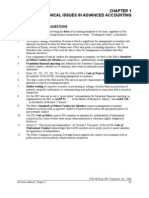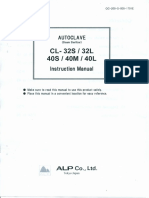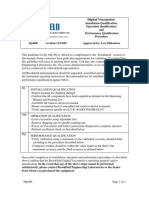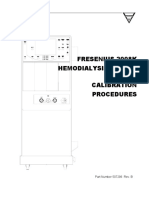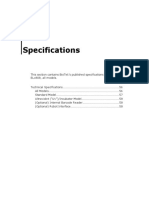3qs008 Digital Brief Amatek
3qs008 Digital Brief Amatek
Uploaded by
Phong LeCopyright:
Available Formats
3qs008 Digital Brief Amatek
3qs008 Digital Brief Amatek
Uploaded by
Phong LeOriginal Title
Copyright
Available Formats
Share this document
Did you find this document useful?
Is this content inappropriate?
Copyright:
Available Formats
3qs008 Digital Brief Amatek
3qs008 Digital Brief Amatek
Uploaded by
Phong LeCopyright:
Available Formats
DV-I, II, III Series, DV2T and
DV3T Viscometers/Rheometers:
Installation Qualification,
Operation Qualification,
and
Performance Qualification
INSTRUMENTATION AND SPECIALTY CONTROLS DIVISION
11 COMMERCE BOULEVARD
Procedure
MIDDLEBORO, MASSACHUSETTS 02346, USA
3Qs008 Revision 7/26/2016 Approved by: Luis Botelho
This guideline for IQ,OQ,PQ is offered as a supplement to the “Installation” section of
this manual. Some customers have particular requirements for validation. It is hoped that
this guideline will assist in meeting those needs. You may also contact Brookfield
AMETEK for a more detailed document, or on-site IQ,OQ,PQ service conducted by a
Brookfield AMETEK representative.
All Brookfield AMETEK instrumentation should be unpacked, assembled and operated
according to the instrument operating instructions. Recommendations for installation,
operation and performance qualification appear below.
IQ: INSTALLATION QUALIFICATION
− Inspect package for shipping damage.
− Confirm that all components have been supplied as detailed in the Operating
Manual and Packing List.
− Assemble lab stand as shown in manual.
− Mount viscometer/rheometer head to assembled lab stand as shown in manual.
− Verify appropriate spindle set (LV #1-#4)(RV/HA/HB #2-#7).
OQ: OPERATION QUALIFICATION
− Level viscometer/rheometer using adjustable feet.
− Remove shipping cap on spindle coupling nut.
− Power on the Viscometer/Rheometer and follow instructions displayed to
complete autozero.
− Perform oscillation check as described on following page.
PQ: PERFORMANCE QUALIFICATION
− Verify calibration using a minimum of one calibrated viscosity standard fluid
according to the procedure described below.
− Centipoise reading should be within the value stated on the fluid ± the
instrument accuracy and the fluid accuracy as defined below.
Comments:_______________________________________________________________________________________
BEL representative:__________________________________ Verified by:____________________________________
Date: 3Qs008 Page 1 of 4
Successful completion of installation, operation and performance procedures as described
above confirm that the Brookfield AMETEK Digital Viscometer/Rheometer is operating
properly and to specification. In the event that any of the above steps cannot be
performed satisfactorily, please contact Brookfield AMETEK or the dealer from
whom you purchased the equipment.
Oscillation check
This check verifies the mechanical condition of the sensing mechanism in the
viscometer/rheometer. Auto-zero the instrument according to directions in the manual.
Do not attach the spindle; the display should show 0.0% torque. The tolerance for this
and all tests is ±0.1%. Gently grasp the viscometer/rheometer’s lower shaft coupling and
lift slightly. Slowly rotate it until the display % reads 10%-15%, then release.
NOTE: For LV units only, the oscillation check should be 0.0% ±0.2%.
DV2T Viscometer and DV3T Rheometer also have an option under the Device Setting
tab, which instructs the user how to perform the Oscillation Checks.
Operational and Calibration Check
Determining Measurement Accuracy
All Brookfield AMETEK instruments are guaranteed to be accurate to within 1% of the
Full Scale Range (FSR) in use. The FSR is simply the maximum viscosity that can be
measured with any spindle/speed combination. Select a specific spindle and rotational
speed. To determine the resulting FSR, consult the manual of the instrument. The %
display will show 100% and the cP display will show the FSR that can be measured
under current choice of spindle and speed. 1% of this value is the measurement accuracy
under these conditions.
Calibration Check for LV (#1-3) and RV, HA, HB (#1-6) Brookfield Spindles
NOTE: The LV #4 (64) and RV, HA, HB #7 (07) spindles have been omitted from this
procedure. Brookfield AMETEK does not recommend the use of these spindles to
perform a calibration check on your instrument. Reasons pertain to the small amount of
spindle surface that makes contact with the viscosity standard, the difficulty of
establishing the immersion mark precisely and the need for precise temperature control at
25°C in the immediate vicinity of the spindle.
In principle, all Brookfield AMETEK rotational viscometer/rheometers are calibrated
torque meters. Brookfield AMETEK offers a variety of viscosity calibration fluids that
enable one to check the calibration and linearity of the instrument over its operating
torque range of 10%-100% torque.
Comments:_______________________________________________________________________________________
BEL representative:__________________________________ Verified by:____________________________________
Date: 3Qs008 Page 2 of 4
Any spindle and any one of several calibration fluids may be used to perform a
calibration check. We recommend using one spindle and one fluid while taking
measurements at multiple speeds. This enables multiple calculations of viscosity
throughout the torque range of the instrument: one at low torque, one at medium torque
and one at high torque. The FSR, and consequently the instrument accuracy in terms of
centipoise, will be different at each speed.
The calibration fluid must be transferred into a 600 mL low form, Griffin beaker (without
creating any bubbles) and, on LV and RV models, the instrument Guard Leg must be
used. See the manual for a description of the use of the Guard Leg. The beaker, fluid,
spindle and Guard Leg must be stabilized at 25.0°C (±0.1°C) before the calibration check
can be performed.
The example below shows typical calibration results using an LV #3 spindle with a
calibration fluid whose actual viscosity is 5,120 cP; the calibration check might look like
the table below. At each speed a different torque is sensed allowing the automatic
computation of viscosity. The allowable error is the sum of 1% of the FSR plus 1% of the
actual value of the calibration fluid. The lower and upper viscosity limits, indicating
acceptable calibration, equal the actual value of the fluid, in this case 5,120 cP; ± the
allowable error.
RPM MIN MAX cP 1% of % cP ALLOWABLE
cP (FSR) FSR Torque READING ERROR
12 1,000 10,000 100 51.2 5120 ± 151
6 2,000 20,000 200 25.5 5100 ± 251
3 4,000 40,000 400 12.7 5080 ± 451
Remember, the total allowable error when conducting a calibration check is the sum of
1% of the FSR plus 1% of the actual value of the calibration fluid itself. The instrument
reading must be within the limits defined by the actual viscosity value of the calibration
fluid ± the allowable error at each speed. The spindle, speeds and fluid you use may be
different from these.
Comments:_______________________________________________________________________________________
BEL representative:__________________________________ Verified by:____________________________________
Date: 3Qs008 Page 3 of 4
Calibration Test Results
A B C D E F G H I
Fluid 1% of Instrument Spindle FSR cP 1% of % Torque Viscosity cP
Value Fluid Model RPM (depress and hold FSR cP
from Value AUTORANGE key)
Certificate cP
cP
Interpretation of Calibration Test Results
The viscosity reading should equal the cP value on the fluid standard to within the
combined accuracies of the Viscometer/Rheometer and the viscosity standard as
calculated below:
Low Limit Reading High Limit Pass or Fail
= A – (B + G) I = A + (B + G)
Any reading outside these limits may indicate a Viscometer/Rheometer problem. Contact
the Brookfield AMETEK technical sales department or your local authorized Brookfield
AMETEK dealer with test results to determine the nature of the problem.
NOTE: A calibration workbook in Microsoft Excel format may be downloaded from
www.brookfieldengineering.com/support/calibration. This workbook contains several
worksheets, which greatly simplify use of the tables above. Instructions for use and
troubleshooting guide are also included.
Brookfield AMETEK recommends repeating this calibration check periodically to insure
Viscosity accuracy and calibration. We suggest every thirty days but your operating
procedures may dictate otherwise.
Comments:_______________________________________________________________________________________
BEL representative:__________________________________ Verified by:____________________________________
Date: 3Qs008 Page 4 of 4
You might also like
- Renault Semiauto GearboxDocument88 pagesRenault Semiauto GearboxSteve Gaddis95% (21)
- Costa Brand GuidelinesDocument7 pagesCosta Brand GuidelinesIzanagi No Okami100% (1)
- Grove Rt-880e-Service ManualDocument346 pagesGrove Rt-880e-Service Manualramiro serrano olliscoNo ratings yet
- Blender Operator Manual PDFDocument16 pagesBlender Operator Manual PDFFrank N100% (1)
- Chapter 01, Modern Advanced Accounting-Review Q & ExrDocument5 pagesChapter 01, Modern Advanced Accounting-Review Q & Exrrlg4814100% (5)
- Fresenius 2008HDocument89 pagesFresenius 2008HBIOCARE SERVICE100% (2)
- Approved By:: Calibration Procedure For Pressure Chart RecorderDocument7 pagesApproved By:: Calibration Procedure For Pressure Chart Recordervinsensius rasaNo ratings yet
- Trailer PMDocument2 pagesTrailer PMArnulfo LavaresNo ratings yet
- Procedure For Calibration of Machines Welding PDFDocument3 pagesProcedure For Calibration of Machines Welding PDFravi00098100% (1)
- SH-005058-UM-6-455N User Manual - (PAxxxx)Document16 pagesSH-005058-UM-6-455N User Manual - (PAxxxx)Med Hédi BANNANI100% (1)
- 04 7341026 Rev E - Performance QualificationDocument6 pages04 7341026 Rev E - Performance QualificationPhong LeNo ratings yet
- Scan Manual ALP CL 32 SDocument61 pagesScan Manual ALP CL 32 SPhong Le100% (2)
- Installation Qualification, Operation Qualification, and Performance Qualification ProcedureDocument3 pagesInstallation Qualification, Operation Qualification, and Performance Qualification ProcedureMARELYS RAMIREZNo ratings yet
- 3qs006 Dial Brief Protocolo BrookfieldDocument4 pages3qs006 Dial Brief Protocolo BrookfieldMelany MonroyNo ratings yet
- Iq Os of ViscometerDocument3 pagesIq Os of ViscometerSurendhiran Ramamoorthy67% (3)
- Fresenius 2008 Hemodialysis System - Calibration ProceduresDocument84 pagesFresenius 2008 Hemodialysis System - Calibration ProceduresALEXANDRE SANTOSNo ratings yet
- Brookfield Manual PDFDocument36 pagesBrookfield Manual PDFAnonymous T32l1RNo ratings yet
- Chauvin Arnoux F05 PDFDocument36 pagesChauvin Arnoux F05 PDFluis2006041380No ratings yet
- Technical Data Sheet Rosemount Magnetic Flowmeter Calibration Verification Report en 74370Document2 pagesTechnical Data Sheet Rosemount Magnetic Flowmeter Calibration Verification Report en 74370KwameOpareNo ratings yet
- IQ-OQ_Titrators HiranumaDocument8 pagesIQ-OQ_Titrators Hiranumaphuhoang1109No ratings yet
- Brookfield 130619014912 Phpapp02Document27 pagesBrookfield 130619014912 Phpapp02imtionmsnNo ratings yet
- Catalog PVTDocument63 pagesCatalog PVTamiddNo ratings yet
- Troubleshooting: Marine IndustrialDocument69 pagesTroubleshooting: Marine Industrialpkunakon1No ratings yet
- RCS4 Auto Level Test Procedure - 2658370928 - 001Document8 pagesRCS4 Auto Level Test Procedure - 2658370928 - 001Olivier SouobouNo ratings yet
- Description of Instrument ....................................................... P-1Document5 pagesDescription of Instrument ....................................................... P-1Anonymous C05BLcNo ratings yet
- Manaul-9407 BDocument101 pagesManaul-9407 Bdaburto250% (2)
- Understanding ISO 6789 - Calibration Laboratories - BlogDocument3 pagesUnderstanding ISO 6789 - Calibration Laboratories - BlogAntmavrNo ratings yet
- HEMODIALISIS Fresenius 2008H CALIBRATION PROCEDURES PDFDocument89 pagesHEMODIALISIS Fresenius 2008H CALIBRATION PROCEDURES PDFpablo100% (1)
- Handout Brookfield ViscometerDocument43 pagesHandout Brookfield ViscometerNomad unknownNo ratings yet
- Approved By:: Calibration Procedure For Torque WrenchesDocument7 pagesApproved By:: Calibration Procedure For Torque Wrenchesvinsensius rasaNo ratings yet
- Chek-Mate Air Flowmeter: Operating InstructionsDocument24 pagesChek-Mate Air Flowmeter: Operating InstructionsManuel GómezNo ratings yet
- Model 5550 HPHT Viscometer ManualDocument72 pagesModel 5550 HPHT Viscometer ManualMalik KNo ratings yet
- Frontload Bill Validator Operation and Service Manual Testing and RepairDocument171 pagesFrontload Bill Validator Operation and Service Manual Testing and Repairpablo bulzomiNo ratings yet
- VC-210 Operation Manual - B PDFDocument9 pagesVC-210 Operation Manual - B PDFdofaneiteNo ratings yet
- AfiMilk MPC Calibration Manual June 2019Document24 pagesAfiMilk MPC Calibration Manual June 2019Mustkim DhukkaNo ratings yet
- ATI 390 User Manual Completed Version - 20180410Document128 pagesATI 390 User Manual Completed Version - 20180410williamppNo ratings yet
- Apache Sprayers 2016 AS1020 AS1220 Owner ManualDocument142 pagesApache Sprayers 2016 AS1020 AS1220 Owner ManualВячеслав ШапочкаNo ratings yet
- Accumulator Charging Valves: Single Charging Valves, Dual Charging Valves, and Load Sensing Charging ValvesDocument27 pagesAccumulator Charging Valves: Single Charging Valves, Dual Charging Valves, and Load Sensing Charging ValvesPedro Mendoza100% (2)
- DTC P0077: Intake Valve Control Solenoid Circuit-High (Bank 1)Document8 pagesDTC P0077: Intake Valve Control Solenoid Circuit-High (Bank 1)miguelNo ratings yet
- The Flow Guide For PT TT Compensation For Crude Oil ManualDocument32 pagesThe Flow Guide For PT TT Compensation For Crude Oil Manualdon121don121No ratings yet
- FAT Procedure (B) 12.10.15Document5 pagesFAT Procedure (B) 12.10.15Richard AdolfNo ratings yet
- DTC P0011Document9 pagesDTC P0011Ronald MoonNo ratings yet
- Calibration ProcedureDocument5 pagesCalibration ProcedureManu SharmaNo ratings yet
- IMO Test Reports LSADocument12 pagesIMO Test Reports LSAMd AmirulNo ratings yet
- Tecn Dairy Cream SepDocument1 pageTecn Dairy Cream SepJonny FabrizzioNo ratings yet
- Max Venturi Service ManualDocument25 pagesMax Venturi Service ManualRafael RamirezNo ratings yet
- Agilent Pilot Scale Purification System - Preventive - Maintenance - ChecklistDocument9 pagesAgilent Pilot Scale Purification System - Preventive - Maintenance - Checklisthienluuduc2011_66877No ratings yet
- SOP For ViscometerDocument3 pagesSOP For ViscometeranjumpqNo ratings yet
- Off-Highway Trucks Tractors V2Document20 pagesOff-Highway Trucks Tractors V2Jayden SimNo ratings yet
- EEX20207 Maintenance Inspection of TransformerDocument26 pagesEEX20207 Maintenance Inspection of TransformerHonesto Bautista100% (1)
- User Manual Stabilizer Perfection SPDocument39 pagesUser Manual Stabilizer Perfection SPfranielNo ratings yet
- Bassy Certificate 2021Document12 pagesBassy Certificate 2021AMUDI EMEKANo ratings yet
- Maintenance and LubricationDocument34 pagesMaintenance and Lubricationtoppen_76100% (1)
- Brookfield - Operational InstructionsDocument35 pagesBrookfield - Operational InstructionsTatiana GadelhaNo ratings yet
- Indian Oil Corporation LTD,: Petreco International (Me) LTDDocument11 pagesIndian Oil Corporation LTD,: Petreco International (Me) LTDDark KnightNo ratings yet
- 8100 Performance Verification Manual 2023.3.2Document22 pages8100 Performance Verification Manual 2023.3.2wang MrNo ratings yet
- Safcii Safc 2 Instruction Manual PDFDocument64 pagesSafcii Safc 2 Instruction Manual PDFdonNo ratings yet
- Click Wrench RepairDocument31 pagesClick Wrench RepairTu PhamNo ratings yet
- TF DSQ Om CDocument31 pagesTF DSQ Om CIulianCioarcaNo ratings yet
- Vertical Storage Tank Calibration by Eodr MethodologyDocument5 pagesVertical Storage Tank Calibration by Eodr MethodologyJahidul Islam100% (1)
- Performance Maintenance Protocol: Acquity Uplc and H-Class System Sample OrganizerDocument11 pagesPerformance Maintenance Protocol: Acquity Uplc and H-Class System Sample OrganizerzhangweiNo ratings yet
- 3 9005 006 Rev B M 2350A GC Controller 0H2S CEM ApplicationDocument32 pages3 9005 006 Rev B M 2350A GC Controller 0H2S CEM ApplicationltrongluanvnNo ratings yet
- 2008K2 Cal Procedures (508137 Rev E)Document84 pages2008K2 Cal Procedures (508137 Rev E)jamal50zNo ratings yet
- 01 7341026 Rev E - IntroductionDocument6 pages01 7341026 Rev E - IntroductionPhong LeNo ratings yet
- 06 7341026 Rev E - System DescriptionDocument14 pages06 7341026 Rev E - System DescriptionPhong LeNo ratings yet
- 03 7341026 Rev E - Operational QualificationDocument10 pages03 7341026 Rev E - Operational QualificationPhong LeNo ratings yet
- 02 7341026 Rev E - Installation QualificationDocument12 pages02 7341026 Rev E - Installation QualificationPhong LeNo ratings yet
- 11 7341026 Rev E - PQ LogbookDocument7 pages11 7341026 Rev E - PQ LogbookPhong LeNo ratings yet
- IQ OQ 800 TS Biotek ReaderDocument8 pagesIQ OQ 800 TS Biotek ReaderPhong LeNo ratings yet
- 07 7341026 Rev E - SpecificationsDocument4 pages07 7341026 Rev E - SpecificationsPhong LeNo ratings yet
- Chemidoc and Chemidoc MP Imaging Systems With Image Lab Touch SoftwareDocument39 pagesChemidoc and Chemidoc MP Imaging Systems With Image Lab Touch SoftwarePhong LeNo ratings yet
- Chemidoc and Chemidoc MP Imaging Systems With Image Lab Touch SoftwareDocument12 pagesChemidoc and Chemidoc MP Imaging Systems With Image Lab Touch SoftwarePhong LeNo ratings yet
- OQ Procedure & Report ALP autoclaveDocument12 pagesOQ Procedure & Report ALP autoclavePhong LeNo ratings yet
- FAQDocument30 pagesFAQPhong LeNo ratings yet
- Module-4 Part-1Document4 pagesModule-4 Part-1ARYAN RAJNo ratings yet
- RX8 Pinout NotesDocument8 pagesRX8 Pinout Notesbrunofcostaferreira83No ratings yet
- Colour Futures 2009Document37 pagesColour Futures 2009Vu Nhan VuongNo ratings yet
- Designand Simulationof Natural Gas Liquid Recovery Processfrom Rich Natural GasDocument11 pagesDesignand Simulationof Natural Gas Liquid Recovery Processfrom Rich Natural Gasmindunder36No ratings yet
- IAD300T - Theory Assignment 1 - 2023Document6 pagesIAD300T - Theory Assignment 1 - 2023Onkgopotse TiroNo ratings yet
- Spouses Mallari Vs Prudential BankDocument1 pageSpouses Mallari Vs Prudential BankMahri Rieanne Delle LangbisNo ratings yet
- Modular TiO2-Squaraine Dyes/Electrolyte Interface For Dye-Sensitized Solar Cells With Cobalt ElectrolyteDocument16 pagesModular TiO2-Squaraine Dyes/Electrolyte Interface For Dye-Sensitized Solar Cells With Cobalt Electrolytebishtrajesh60No ratings yet
- BFM Vishay SoodDocument6 pagesBFM Vishay Soodpwtngfsk4dNo ratings yet
- Review of Related Studies and LiteratureDocument50 pagesReview of Related Studies and LiteratureKriix NaaNo ratings yet
- Computer Evolution WorksheetDocument1 pageComputer Evolution WorksheetNur Atiah Daud50% (2)
- Hazardous Area ClassificationDocument5 pagesHazardous Area ClassificationS S V Jagannadha Sarma GummaNo ratings yet
- 5 Vincent Mattelaer ToyotaDocument20 pages5 Vincent Mattelaer ToyotaRaj ThakurNo ratings yet
- 5000LPH Ro PlantDocument5 pages5000LPH Ro PlantYash HariaNo ratings yet
- Arc 400 CommanderDocument1 pageArc 400 Commandermanoj_doshi_10% (1)
- Crenlo Uaw Memo Apr 2021 VfinalDocument1 pageCrenlo Uaw Memo Apr 2021 VfinalErich FisherNo ratings yet
- 10 PHY ICSE X Electro MagnetismDocument15 pages10 PHY ICSE X Electro MagnetismsktigergamingNo ratings yet
- CNHS HistoryDocument1 pageCNHS Historyjohn rexNo ratings yet
- 2.2.4.10 Packet Tracer - Troubleshooting Switch Port Security InstructionsDocument1 page2.2.4.10 Packet Tracer - Troubleshooting Switch Port Security InstructionsAndrewNo ratings yet
- Rifacademy Ilt 9851 Session 93 UsersDocument33 pagesRifacademy Ilt 9851 Session 93 UsersOeun PenhNo ratings yet
- Application To Pay Voluntary Class 3 National Insurance ContributionsDocument4 pagesApplication To Pay Voluntary Class 3 National Insurance ContributionsCalso MedNo ratings yet
- Y-Bc0035 GBDocument4 pagesY-Bc0035 GBYousef AlipourNo ratings yet
- TS-403-v3-2 Mesa LabsDocument4 pagesTS-403-v3-2 Mesa LabsRasmi PNo ratings yet
- Lecture 7: Principles of Microwave Earth Observation: Week 8Document10 pagesLecture 7: Principles of Microwave Earth Observation: Week 8Jayesh ShindeNo ratings yet
- HC Land Division 2014-32-0Document27 pagesHC Land Division 2014-32-0Namamm fnfmfdnNo ratings yet
- Lecture Three Hoisting Equipment: OutlinesDocument55 pagesLecture Three Hoisting Equipment: OutlinesYonatan TaddeseNo ratings yet
- Offmav: E-Ticket Itinerary & ReceiptDocument3 pagesOffmav: E-Ticket Itinerary & ReceiptAristya Julianto SidhartaNo ratings yet
- International Harvard BrochureDocument2 pagesInternational Harvard Brochuretayyuhong2023No ratings yet
- Marketing Aspects of International BusinessDocument249 pagesMarketing Aspects of International BusinessFreaka MamacitaNo ratings yet




